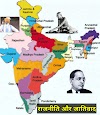The Tragic Mystery of Air India Flight AI171: Unraveling the Crash and the Role of Pilot Dynamics
Update:
Posted on PoliticalFunda.com | June 13, 2025
On June 12, 2025, the skies above Ahmedabad turned somber as Air India Flight AI171, a Boeing 787-8 Dreamliner bound for London Gatwick, plummeted just seconds after takeoff, claiming 265 lives in one of India’s deadliest aviation disasters. With one survivor and a community in mourning, the world is left grappling with a haunting question: What caused this tragedy? As investigators sift through wreckage and data, early clues point to a possible mix of technical mishaps and human factors. Among the swirling theories, one question stands out: Could the stark experience gap between the pilots have led to a breakdown in Crew Resource Management (CRM), tipping the scales toward catastrophe? Let’s dive into the unfolding mystery of AI171 with a fresh perspective, piecing together what we know—and what we don’t.
A Catastrophic 30 Seconds
Picture this: a warm Ahmedabad evening, 40°C, the runway buzzing with the roar of a fully loaded Dreamliner carrying 242 souls. AI171 lifts off from Sardar Vallabhbhai Patel International Airport, climbing to a mere 625 feet before something goes horribly wrong. Within 30 seconds, the aircraft issues a Mayday call, falls silent, and crashes into a residential area, leaving a trail of devastation. Videos circulating online capture the chilling sight: landing gear still down, wing flaps oddly retracted, and a sluggish climb that ends in a fiery plunge. What could turn a routine takeoff into such a rapid disaster?
The Suspects: Configuration, Engines, or Human Error?
While the black box—partially recovered—holds the key to truth, experts are buzzing with theories based on early evidence:
Flaps Up, Gear Down: A Deadly Misstep?
Video footage reveals a jaw-dropping anomaly: the aircraft’s wing flaps, critical for generating lift during takeoff, were fully retracted at just 600 feet. For a Boeing 787, heavy with 100 tonnes of fuel for a long-haul flight, this is akin to asking a bird to fly without spreading its wings. Standard procedure demands flaps set at 5 or higher for takeoff, gradually retracting as speed builds. Did the pilots miss a checklist item? Did the takeoff configuration warning system fail to sound the alarm? Meanwhile, the landing gear remained extended, adding drag and hinting at either a deliberate choice (perhaps anticipating an emergency return) or a distraction in the cockpit. This configuration puzzle is a leading suspect.
Engines in Distress?
The plane reached a sluggish 174 knots—far below the expected speed for a 787. Some experts point to a possible dual engine failure, though this is rare for a modern jet designed to climb on one engine if needed. A survivor’s account of a “loud bang” fuels speculation of a bird strike, common at Ahmedabad’s bird-prone airport, or even fuel delivery issues starving the engines. A plume of dust seen in videos as the plane crossed the runway suggests low thrust, but was it mechanical failure, contamination, or something else? The odds of both engines failing simultaneously are slim, making this theory intriguing but uncertain.
The Human Factor: A Pilot’s Burden
With only seconds to react, the crew faced immense pressure. The pilots issued a Mayday call but went radio-silent afterward, suggesting they were wrestling with a crisis. Could a misstep—like entering incorrect data into the flight management computer (e.g., wrong weights or temperature)—have set off a chain reaction? Hot weather and a heavy load demand precise calculations, and a small error could spell disaster. But the bigger question looms: Did the pilots’ differing experience levels play a role?
The Experience Gap: Was CRM the Weak Link?
At the helm was Captain Sumeet Sabharwal, a seasoned veteran with over 8,200 hours of flight time and 22 years as a commercial pilot. His co-pilot, First Officer Clive Kundar, had 1,100 hours—respectable for a co-pilot but a stark contrast to the captain’s expertise. In the high-stakes world of aviation, Crew Resource Management (CRM)—the art of seamless communication, decision-making, and teamwork in the cockpit—is a lifeline. Could the experience gap have strained this dynamic?
A Pressure-Cooker Cockpit: The 30-second window from takeoff to crash left no room for error. If an emergency like an engine issue or configuration warning erupted, the crew needed to act in sync. The captain, likely leading the response, relied on the co-pilot to monitor instruments, verify checklists, or challenge decisions. A less experienced co-pilot might hesitate to question a seasoned captain or struggle to keep pace in a chaotic moment, potentially missing critical cues like the retracted flaps.
Echoes of Past Tragedies: History offers sobering parallels. In the 1989 British Midlands crash, a seasoned crew misdiagnosed an engine failure, shutting down the wrong engine due to poor CRM and training gaps. If AI171’s pilots faced a similar split-second decision—say, misinterpreting a warning or mishandling a stall—CRM could have been the linchpin. The extended landing gear and retracted flaps suggest a possible distraction or oversight, but without cockpit voice recorder data, we can’t say if communication broke down.
The Counterpoint: Experience gaps are common in cockpits, and modern training, checklists, and automation are designed to bridge them. Captain Sabharwal’s expertise should have been a stabilizing force, and Air India’s procedures likely emphasized CRM. Still, under extreme pressure, even the best systems can falter.
The Investigation: A Race for Answers
One black box is in hand, with the second still missing amidst the wreckage. Indian authorities, joined by the US NTSB, UK investigators, and Boeing, are piecing together the puzzle. Was it a mechanical gremlin, a maintenance oversight, or a human error amplified by the heat of the moment? The 787’s stellar safety record—AI171 was its first fatal crash—adds urgency to the probe. A preliminary report is expected in 3–6 months, but a full picture may take years.
Voices from the Void: Social Media Speculation
On platforms like X, armchair analysts are abuzz. Some point to pilot error, like premature flap retraction or automation misuse. Others whisper of electronic failures or fuel issues. While these theories fuel debate, experts urge restraint—rushing to judgment risks clouding the truth and disrespecting the victims’ families. The survivor’s account of a “loud bang” adds intrigue, but without data, it’s just one piece of a shattered mosaic.
A Sobering Reflection
The loss of AI171 is a stark reminder of aviation’s delicate balance: cutting-edge technology, human skill, and unforgiving physics. Whether it was a misconfigured wing, a silent engine, or a fleeting lapse in teamwork, the tragedy underscores the stakes of every takeoff. The experience gap between the pilots raises valid questions about CRM, but pinning the blame there without evidence is premature. As we await the black box’s secrets, let’s honor the 265 lives lost by seeking truth over speculation, ensuring their legacy strengthens the skies we all share.
What do you think caused AI171’s crash? Share your thoughts below, but let’s keep it respectful as the investigation unfolds.
Note: For the latest updates, follow credible sources or check back here. If you’re curious about Air India’s response or want to dive deeper into aviation safety, let me know!
Sources: Web reports, expert analyses, and X posts reviewed as of June 13, 2025.










0 Comments